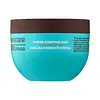What's inside
What's inside
 Benefits
Benefits

 Concerns
Concerns

 Ingredients Side-by-side
Ingredients Side-by-side

Water
Skin ConditioningCetyl Alcohol
EmollientBehenalkonium Chloride
Propylene Glycol Ceteth-3 Acetate
EmollientParfum
MaskingTridecyl Stearate
EmollientNeopentyl Glycol Dicaprylate/Dicaprate
EmollientTridecyl Trimellitate
EmollientDisodium EDTA
Hydrolyzed Keratin
HumectantArgania Spinosa Kernel Oil
EmollientMagnesium Nitrate
Butylene Glycol
HumectantAcetic Acid
BufferingMethylchloroisothiazolinone
PreservativeMethylisothiazolinone
PreservativePhenoxyethanol
PreservativeMagnesium Chloride
Ethylhexylglycerin
Skin ConditioningWater, Cetyl Alcohol, Behenalkonium Chloride, Propylene Glycol Ceteth-3 Acetate, Parfum, Tridecyl Stearate, Neopentyl Glycol Dicaprylate/Dicaprate, Tridecyl Trimellitate, Disodium EDTA, Hydrolyzed Keratin, Argania Spinosa Kernel Oil, Magnesium Nitrate, Butylene Glycol, Acetic Acid, Methylchloroisothiazolinone, Methylisothiazolinone, Phenoxyethanol, Magnesium Chloride, Ethylhexylglycerin
Water
Skin ConditioningStearyl Alcohol
EmollientGlycerin
HumectantDimethicone
EmollientCetyl Alcohol
EmollientArgania Spinosa Kernel Oil
EmollientParfum
MaskingGuar Hydroxypropyltrimonium Chloride
Skin ConditioningHydroxypropyl Guar Hydroxypropyltrimonium Chloride
Panthenol
Skin ConditioningGlucose
HumectantGlyceryl Stearate
EmollientAcrylates Copolymer
Cetearyl Alcohol
EmollientCetearyl Glucoside
EmulsifyingPEG-100 Stearate
Polyquaternium-37
PPG-1 Trideceth-6
Skin ConditioningSteareth-2
EmulsifyingCaprylyl Glycol
EmollientPropylene Glycol
HumectantPropylene Glycol Dicaprylate/Dicaprate
EmollientCitric Acid
BufferingDisodium EDTA
Isopropyl Alcohol
SolventSorbitan Oleate
EmulsifyingStearamidopropyl Dimethylamine
EmulsifyingChlorphenesin
AntimicrobialBehentrimonium Chloride
PreservativeCetrimonium Chloride
AntimicrobialPhenoxyethanol
PreservativeCI 15985
Cosmetic ColorantCI 19140
Cosmetic ColorantAlpha-Isomethyl Ionone
PerfumingLinalool
PerfumingHydroxycitronellal
PerfumingWater, Stearyl Alcohol, Glycerin, Dimethicone, Cetyl Alcohol, Argania Spinosa Kernel Oil, Parfum, Guar Hydroxypropyltrimonium Chloride, Hydroxypropyl Guar Hydroxypropyltrimonium Chloride, Panthenol, Glucose, Glyceryl Stearate, Acrylates Copolymer, Cetearyl Alcohol, Cetearyl Glucoside, PEG-100 Stearate, Polyquaternium-37, PPG-1 Trideceth-6, Steareth-2, Caprylyl Glycol, Propylene Glycol, Propylene Glycol Dicaprylate/Dicaprate, Citric Acid, Disodium EDTA, Isopropyl Alcohol, Sorbitan Oleate, Stearamidopropyl Dimethylamine, Chlorphenesin, Behentrimonium Chloride, Cetrimonium Chloride, Phenoxyethanol, CI 15985, CI 19140, Alpha-Isomethyl Ionone, Linalool, Hydroxycitronellal
 Reviews
Reviews

Ingredients Explained
These ingredients are found in both products.
Ingredients higher up in an ingredient list are typically present in a larger amount.
You may know this ingredient as argan oil. Argan Oil has antioxidant, hydrating, and soothing properties.
Studies have shown argan oil can help fight again radical damage from the sun. This makes it effective at preventing hyperpigmentation.
Large amounts of vitamin E found in argan oil helps the skin retain water. Argan oil also contains fatty acids such as linoleic acid, oleic acid, and palmitic acid. It is also a good source of lipids.
Another benefit of argan oil is skin-soothing. It can help reduce inflammation-related skin symptoms.
Argan Oil is effective at regulating sebum production in pores. This can make it effective at treating hormonal acne.
Traditionally, argan oil was used for its antibacterial and antifungal properties. However, argan oil contains fatty acids that may make it not fungal-acne safe.
Argan Trees are native to Morocco.
Learn more about Argania Spinosa Kernel OilCetyl Alcohol is a fatty alcohol. Fatty Alcohols are most often used as an emollient or to thicken a product.
Its main roles are:
Though it has "alcohol" in the name, it is not related to denatured alcohol or ethyl alcohol.
The FDA allows products labeled "alcohol-free" to have fatty alcohols.
Learn more about Cetyl AlcoholDisodium EDTA plays a role in making products more stable by aiding other preservatives.
It is a chelating agent, meaning it neutralizes metal ions that may be found in a product.
Disodium EDTA is a salt of edetic acid and is found to be safe in cosmetic ingredients.
Learn more about Disodium EDTAParfum is a catch-all term for an ingredient or more that is used to give a scent to products.
Also called "fragrance", this ingredient can be a blend of hundreds of chemicals or plant oils. This means every product with "fragrance" or "parfum" in the ingredients list is a different mixture.
For instance, Habanolide is a proprietary trade name for a specific aroma chemical. When used as a fragrance ingredient in cosmetics, most aroma chemicals fall under the broad labeling category of “FRAGRANCE” or “PARFUM” according to EU and US regulations.
The term 'parfum' or 'fragrance' is not regulated in many countries. In many cases, it is up to the brand to define this term.
For instance, many brands choose to label themselves as "fragrance-free" because they are not using synthetic fragrances. However, their products may still contain ingredients such as essential oils that are considered a fragrance by INCI standards.
One example is Calendula flower extract. Calendula is an essential oil that still imparts a scent or 'fragrance'.
Depending on the blend, the ingredients in the mixture can cause allergies and sensitivities on the skin. Some ingredients that are known EU allergens include linalool and citronellol.
Parfum can also be used to mask or cover an unpleasant scent.
The bottom line is: not all fragrances/parfum/ingredients are created equally. If you are worried about fragrances, we recommend taking a closer look at an ingredient. And of course, we always recommend speaking with a professional.
Learn more about ParfumPhenoxyethanol is a preservative that has germicide, antimicrobial, and aromatic properties. Studies show that phenoxyethanol can prevent microbial growth. By itself, it has a scent that is similar to that of a rose.
It's often used in formulations along with Caprylyl Glycol to preserve the shelf life of products.
Water. It's the most common cosmetic ingredient of all. You'll usually see it at the top of ingredient lists, meaning that it makes up the largest part of the product.
So why is it so popular? Water most often acts as a solvent - this means that it helps dissolve other ingredients into the formulation.
You'll also recognize water as that liquid we all need to stay alive. If you see this, drink a glass of water. Stay hydrated!
Learn more about Water